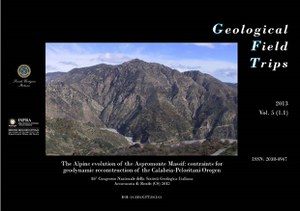The Alpine evolution of the Aspromonte Massif: contraints for geodynamic reconstruction of the Calabria-Peloritani Orogen
86° National Congress of the Geological Society of Italy - Arcavacata di Rende (CS), 2012
The two-days field trip in the Aspromonte Massif within a suggestive national park district, carried out for the 86° Congress of the Geological Society of Italy, is planned at illustrating the tectono-metamorphic history of the metamorphic basement outcropping in this sector of the southern Apennine chain trough the direct observation of some key sectors, focussing the attention on the complex polymetamorphic-polyphase evolution that, since the Precambrian-Cambrian boundary, have driven the crystalline basement rocks petrogenetic evolution, as well as the structural features, producing the present-day massif physiography. The Aspromonte Massif (Calabria) constitutes together with the Peloritani Mountains (Sicily) the southern sector of the CPO (Calabria-Peloritani Orogen), a segment of the actual southern Apennine chain outcropping in the central Mediterranean area due to the breakup of the original Southern European Variscan chain during Mesozoic-Cenozoic Alpine orogeny.
The overall structural architecture of the Aspromonte Massif can be schematically described as a nappe-pile edifice made up by metamorphic terrains partly covered by a fragmentary Mesozoic-Cenozoic sedimentary cover. From top to the bottom the tectonic slices of the metamorphic units are named as follow: Stilo Unit (SU), Aspromonte Peloritani Unit (APU) and Madonna di Polsi Unit (MPU). This last unit outcrops in three main tectonic windows named as Madonna di Polsi, Samo-Africo and Cardeto, respectively. The two uppermost tectonic slices are partly sutured by the Oligocene-Miocene silico-clastic Stilo-Capo d’Orlando formation (SCOF), partly covered in turn by the back-thrusting of the antisicilidi clays, which close the sequence of the nappepile tectonic stack. Finally, at the top of the sequence, the neo-authoctonous sedimentary sequences outcrop, as for instance those represented by the Gessoso-Solfifera sedimentary sequences, widely outcropping along the Ionian flank of the Aspromonte Massif.
DOI 10.3301/GFT.2013.01

